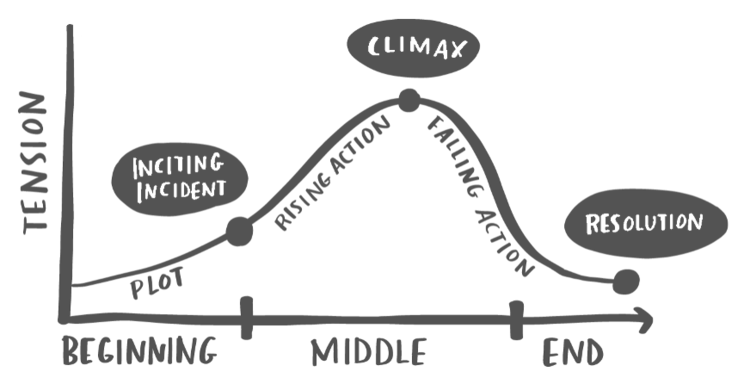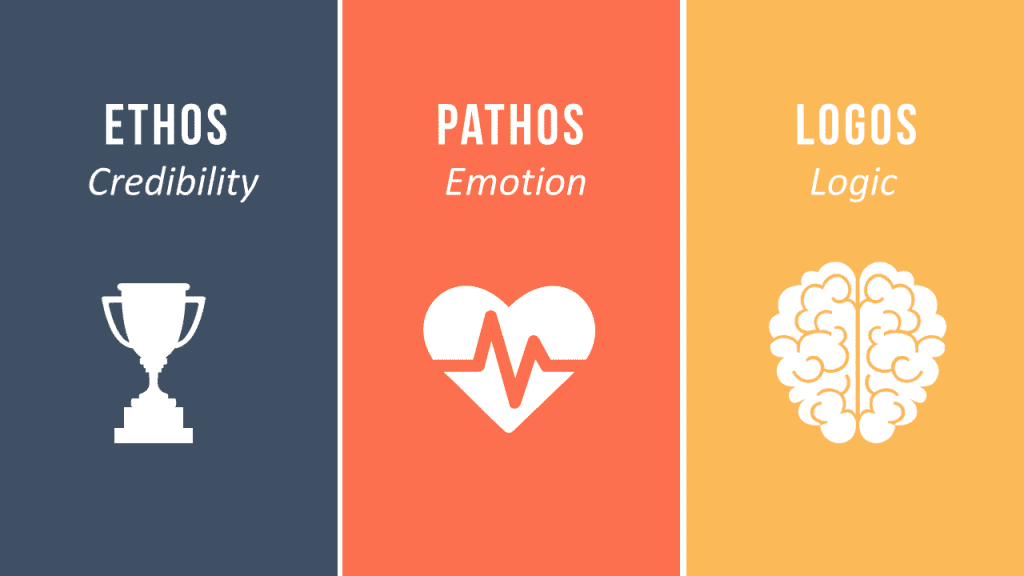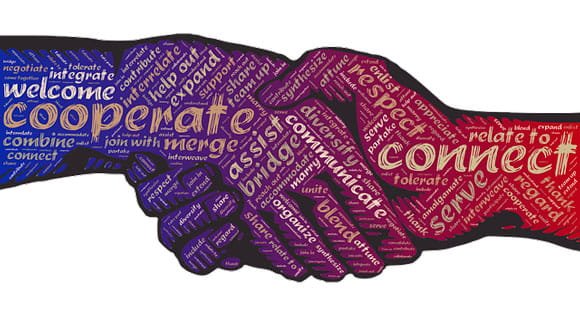1. Communication Skills
How do Product Managers get things done?
Product Managers get things done by communicating with a number of different people.

Communication is an incredible important skill for a product manager to have and it can take a lot of different forms, whether that’s email, in-person, presentations or even written documents like PRDs (product requirements document). As a Product Manager, it’s important to be able to effectively communicate your ideas and get people excited about them.
- Active Listening – a big part of communication is listening to really understand other perspectives and points of views so you can respond more effectively.
- Storytelling – a way to simplify your message, make it more engaging on an emotional level, and create something that’s more memorable and easy for people to remember.
- Being Persuasive – how you structure your message in a way that’s compelling to your audience.
- Presentations – you’ll spend a lot of time making presentations and building slide decks which need to follow.
- Negotiation – the different strategies that you can employ
2. Active Listening
Everything starts with listening.
With communication, everything starts with listening. Whether it’s to customers, leadership or the team. You need to listen in order to understand other perspectives and needs. Listening can also help to build relationships, promote understanding, and build empathy.

It can also help to save time and make sure things are done right the first time.
What is active listening?
- More than just listening – Listening is really important, but often times communication is not just about what was said, but how it was said. You have to read between the lines, as well as be aware of body language.
- Being an engaged listener – Means your paying attention to the person who’s speaking, and making sure they know they have your full attention. There shouldn’t be any distractions.
- Fully understanding other points of view – You don’t have to agree with those other points of view, but you do need to understand those views as if you were in the other person’s shoes.
- Not imposing your own views – You listening so you’re role is not to judge or offer alternative views at this point. It’s just to listen and understand exactly where the other person is coming from.
Why is active listening important?
Two really big benefits.
- Builds relationships – It helps to build strong relationships. By actively listening, you’re building empathy for the other person’s point of view and you’re also showing that you care about understanding their perspective. This can go a really long way towards building strong relationships.
- Promotes understanding – You don’t just learn what the other person’s point of view is. You understand the context behind why they ave that point of view and how they got there. This gives you a much deeper level of understanding. It an help you to anticipate how they might treat to certain things in the. future.

Tips
- Make eye contact and smile – you want them to feel relaxed when talking to you.
- Provide encouragement – acknowledging what the other person is saying – nodding your head, small comments like, “Yes”, “mmhm”, or ” makes sense”
- Don’t interrupt – give the other person the space to complete their thoughts. You want to avoid interrupting them. Let them finish that they’re saying and make sure you hear and fully understand what they’re saying.
- Ask clarifying questions when needed – if you’re not sure what they’re saying wait until there’s a pause and ask them if they can clarify. Phrase your questions in a way that avoids judgement. The best types of questions are open-ended, where you genuinely want to understand their point of view.
- Paraphrase – It’s really important to paraphrase and mirror back what you just heard. This makes sure that you’re really understanding what the person is saying and gives them an opportunity to correct you if you misheard. “Just to make sure I’m understand, I think that you said … Did I get that right?”
3. Storytelling
Product Managers are Storytellers
Storytelling is a powerful tool that you can use to create more tangible narratives. Storytelling is a tool that allows you to express your vision and thoughts through more compelling, tangible narratives, an it makes it easier for people to understand and relate to what you’re explaining. Storytelling explains what AND why. This is because they story explains not just what happens, but why it’s happening as well. Stories explain the rationale behind what’s going on.

This provides the audience with deeper insight and understanding around motives. Stories also have an emotional element. When you tell a story the audience builds an attachment to characters in that story. This creates more of an emotional response and gets the audience invested in the outcomes of the story. Stories can also be exciting and when you get people excited about solving the problem, they’re really going to create about slog the problem and be invested in it.
- Powerful tool to create more tangible narratives
- What AND why
- Emotional response
- Creates excitement
- Part if the core role of being a Product Manager
storytelling is a core role of being a Product Manager
Product Managers need to tell stories all the time. Whether it’s explaining your roadmap to leadership and the larger company or building user stories for the design and engineering team to execute against. Stories are a great way to inspire the team and get everyone excited.
Elements of a story
There are elements that go into a story. Firstly you have the hero. This is your user, who they are, what they care about, their background. Next there’s a goal. This is what the hero is trying to accomplish. But before they can achieve their goal, they encounter a villain or a problem that’s preventing the hero from getting to where they’re trying to go, and that’s where the sidekick comes in to help.

The sidekick in most cases is going to be your product. The lastly, you have the plot, which describes how the hero and the sidekick defeat the villain and achieve their goal.
- Hero
- Goal
- Villain
- Sidekick
- Plot
What goes into crafting a story?
You’re going to want to start with the big picture. It’s important to start with the big picture and provide context. You’ll want to make sure that you understand who your audience is and what they care about. You’ll also want to think about how you want them to feel at the end of the story an what actions you want them to take if any. Then you’ll want to describe the problem or the conflict. It’s usually helpful to start by explaining how we got here and why did this problem arise in the first place. You can also touch on why this is an important problem to solve and what’s currently preventing your user from reaching their goal.
- Start with the big picture
- What’s the problem?
- How the hero and your product get to the resolution
- So what? Describe the impact and conclusion
Then comes the plot for how to get to resolution. You want to make sure to include enough imagery and detail so that they audience gets a mental image in their mind. The more personal you can make it, the better. How does your product help the user t reach their goal? How is that any better than other options that are available? Lastly you’ll want to talk about the impact an the conclusion. How as the problem ultimately solved? Why does it matter that it was solved? What does it mean for the user?
Tips
The simpler the message is, the more that it will get across to your audience. After you’ve created your story, one of the things that you can do is you can ask yourself how you would tell the same story, and just half the time. That’s a really great way to go through and ask yourself and find out f you actually need every single element that you’ve created so far.
- Keep it simple
- Make it memorable
- Show, don’t tell
- Prc
You also want to make your story memorable. You want people to be able to remember the important parts of your story, and a really great way to do this is by making it more personal and relatable, and by having emotional moments that people might have experienced themselves. Another thing that you can do with a story is you can show why things matter rater than telling or explaining.
You don’t want to explain what your product does in detail, but you can show what it does and you can show its impact. You can show how people would use it ad what they’re using it. Potentially this is the point that you can include mocks or demos of your product as well. Another super important thing is to practice, practice, practice, practice. You should be able to tell the story without having to refer to any notes. This doesn’t mean the you’ve memorised it word for word though.
4. Creating a story
Why are you learning about being a Product Manager?

This is a story about you…
- Why are you learning about being a Product Manager?
- How did you hear about Product Management?
- What led you to Product Management?
- What do you hope to get out of a career as a Product Manager?
- Why are those things important to you?
- Also share some challenges you’ve had or think you’ll have along the way…
- Where do you want to see yourself in one years time?
- Practice telling the story to yourself, by rehearsing your story out loud in front of a mirror
Share your story with a friend
After you’ve shared the story ask your friend:
- Summarise the story
- Explain how the story made you feel
- Describe what they thought was the most important takeaway
Think about how their responses compared to what you were expecting them to say, and if they were different? Why do you think they were different?
5. Being Persuasive
How do you create persuasive arguments and why does persuasion matter?
Identifying Problems
For a product manager it takes a handful of people to build a product, and you work with all of them. To build a successful product the team needs to be aligned and moving as a group in the same direction. But you don’t have direct authority over everyone you work with. So you can’t just tell them what to do or believe. Instead, you have to convince them. You have to persuade them.
- You work with lots of people
- The team needs to be aligned
- You don’t have direct authority over everyone
Types of persuasion
There are three different modes of persuasion according to Aristotle, a Greek philosopher. There’s ethos, which is your credibility as an individual. This happens when you are qualified to speak on a topic, or after you’ve spent time working with the team, you will earn and gain the trust of your team. But this trust is also something that can be achieved through your personal character, background, and other achievements .

There’s also pathos, which is emotion and making your audience feel a certain way. Lastly there’s logos, which is logic, and this is building an argument based on fact and data. These are truths that can’t be refuted. The best messages have all three. It’s important to think of these types of persuasion as interconnected rather than stand-alone.
For example, having strong logic and data will increase your credibility, and using certain pieces if data might actually provoke an emotional response from your audience. You can also use well-placed humour to help you connect with your audience and gain more credibility.
How can you build persuasive messages?
You need to know your audience. It’s really important to understand who your audience is and what they care about. This allows you to tailor your message to specifically address those concerns. Next you need to pick a viewpoint. Be decisive. Pick a viewpoint and explain why it’s the best outcome. Don’t try and explain all the different options. This just dilutes your message and creates confusion around what it is your actually recommending. You need to know all of the other perspectives and be ready to speak to them if they come up, including the associated pros and cons of each.
- Know your audience
- Pick a viewpoint
- Know the other perspective
- Be data driven
- Discuss objections
- End with a call to action
You’ll also want to be data-driven. Support your claims with data. Don’t go over the top, but have a few key data points the can really help you to drive your message home. Another important thing is to discuss objections. When objections or questions come up, don’t try and dismiss them. This will actually make you seem defensive. Instead, have a real discussion around the merits of those other viewpoints and try to get the group to a consensus on them. This shows the audience that you care about their viewpoint and that you’re also invested in getting to the best possible solution, whether or not it’s your own idea.
Lastly, you’ll want to end with a call to action. So you’ve just finished your presentation and you have the whole group aligned with your point of view. Make sure to wrap it up by outlining the next steps so that everyone understands what was agreed upon and what will happen next.
Remember, you’re not going to win every discussion and that’s okay. But over time, what will happen us you’ll build confidence in yourself and how to best prepare, and the people that you work with will also build confidence in your ability to deliver.
6. Negotiation
Product Managers have to negotiate every single day.
Negotiation is about trying to reach an agreement when there’s conflict. Conflict can arise in lots of different scenarios, whether it’s about what the product should do, who’s going to be working on the product or the specific timelines of what’s happening when. Negotiation also involves compromise, which is about finding the best mutual outcome for all parties involved.

When you’re negotiating people tend to think of it as either being a win or lose situation. But theres actually a couple of different styles of negotiation. There’s There’s .
- Competitive negotiation where I’m going to win and you’re going to lose.
- Collaborative negotiation, where you and I both walk away feeling like we won
- Compromise negotiation, where we both walk away feeling like we won and lost some parts of the negotiation
- Avoidance, where we both lose and this usually happens when people don’t like conflict and as a result issues end up not being directly discussed
- Accommodation, this is where I lose and you win. This isn’t in my best interests but sometimes might be needed in order to preserve relationships.
These styles will all come into play at different times. But most of the time when you’re working with your team and within your company, collaborative negotiation is going to be the best approach.
Negotiation strategies
The best first step is to understand what each side’s BATNA is. Think about what would happen if you weren’t able to reach an agreement? What would the outcome be for each party? Another important thing is to focus on interests. It’s really helpful to understand what each side us interested in and why? These insights will help you to understand where to focus during the rest of the negotiation.

- BATNA (Best Alternative To a Negotiated Agreement)
- Focus on interests
- Make the pie bigger
- Use objective criteria
- Multiple solutions
Another great strategy is to make the pie bigger. You’ll want to look for ways that you can increase the value of the negotiation. You can do this by understanding the other side’s interests. Are there any things you can offer them (without it costing you anything) that will be valuable for them?
You can also objective criteria, it helps to base the conversation in reality. Using objective criteria help to ground a conversation by looking at similar things and using them as a comparison. It can also be helpful to present multiple solutions. When you do this you will get feedback about how the other side feels about each option and which option they think is the best.
Interactions:
- Align on problem definition and scope
- Review PRD (Product Requirement Doc) and mocks
- Compromise on ideal design solution vs technical limitations or timeline pressure
Tips for Negotiation
- Build strong relationships
- User active listening – the better you understand their motivations the easier it will be to find a solution
- Keep emotions in check
- Work together to find. a solution – align on goals, it’s easier to figure out how to get there.